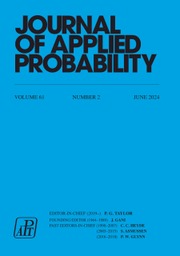Dear Editor,
Kemeny’s constant for infinite DTMCs is infinite
Consider a positive recurrent discrete-time Markov chain
![]() ${(X_n)}_{n \ge 0}$
with (countable) state space
${(X_n)}_{n \ge 0}$
with (countable) state space
![]() $\mathcal{S}$
. For
$\mathcal{S}$
. For
![]() $x\in \mathcal{S}$
, define the positive hitting time
$x\in \mathcal{S}$
, define the positive hitting time
![]() $T_x=\inf\{n\ge 1\colon X_n=x\}$
and the hitting time
$T_x=\inf\{n\ge 1\colon X_n=x\}$
and the hitting time
![]() $\theta_x=\inf\{n\ge 0\colon X_n=x\}$
. Let
$\theta_x=\inf\{n\ge 0\colon X_n=x\}$
. Let
![]() $\mathbb{P}_x$
denote the law of the process started from state x, and let
$\mathbb{P}_x$
denote the law of the process started from state x, and let
![]() $\mathbb{E}_x$
denote the corresponding expectation. It was observed by Kemeny and Snell [Reference Kemeny and Snell3] that, when
$\mathbb{E}_x$
denote the corresponding expectation. It was observed by Kemeny and Snell [Reference Kemeny and Snell3] that, when
![]() $\mathcal{S}$
is finite, the expected hitting time of a random stationary target, i.e. the quantity
$\mathcal{S}$
is finite, the expected hitting time of a random stationary target, i.e. the quantity
does not depend on x. (Here
![]() ${\pi}=(\pi_y)_{y \in \mathcal{S}}$
is the stationary distribution for the chain.) Thus, the quantity
${\pi}=(\pi_y)_{y \in \mathcal{S}}$
is the stationary distribution for the chain.) Thus, the quantity
![]() $\kappa=\kappa_x$
in (1) is called Kemeny’s constant. Considerable effort has been devoted to giving an ‘intuitive’ proof of this result. In [Reference Bini, Hunter, Latouche, Meini and Taylor1] it was argued that it is more natural to consider the quantity
$\kappa=\kappa_x$
in (1) is called Kemeny’s constant. Considerable effort has been devoted to giving an ‘intuitive’ proof of this result. In [Reference Bini, Hunter, Latouche, Meini and Taylor1] it was argued that it is more natural to consider the quantity
Note that
![]() $\mathbb{E}_x[\theta_y]=\indic{ y\ne x}\mathbb{E}_x[T_y]$
, from which it follows that
$\mathbb{E}_x[\theta_y]=\indic{ y\ne x}\mathbb{E}_x[T_y]$
, from which it follows that
![]() $\kappa_x=1+\omega_x$
(since
$\kappa_x=1+\omega_x$
(since
![]() $\pi_x\mathbb{E}_x[T_x]=1$
). For finite
$\pi_x\mathbb{E}_x[T_x]=1$
). For finite
![]() $\mathcal{S}$
, Hunter [Reference Hunter2] established the sharp bound
$\mathcal{S}$
, Hunter [Reference Hunter2] established the sharp bound
![]() $\kappa\ge
(|\mathcal{S}|+1)/2$
(the bound is achieved by the directed non-random walk on the cycle). It was conjectured in [1, p. 1031] that
$\kappa\ge
(|\mathcal{S}|+1)/2$
(the bound is achieved by the directed non-random walk on the cycle). It was conjectured in [1, p. 1031] that
![]() $\kappa$
is infinite for any infinite state chain. In this note we verify this conjecture.
$\kappa$
is infinite for any infinite state chain. In this note we verify this conjecture.
Theorem 1. For an irreducible positive recurrent, discrete-time Markov chain with infinite state space and for any
![]() $x\in\mathcal{S}$
, we have
$x\in\mathcal{S}$
, we have
![]() $\kappa_x =
\smash{\sum_{y\in\mathcal{S}} \pi_y \mathbb{E}_x[T_y]} = \infty$
.
$\kappa_x =
\smash{\sum_{y\in\mathcal{S}} \pi_y \mathbb{E}_x[T_y]} = \infty$
.
This theorem is an immediate consequence of the following result.
Lemma 1. Let
![]() $\mathcal{S}$
be finite or infinite. Then, for every
$\mathcal{S}$
be finite or infinite. Then, for every
![]() $x,y\in \mathcal{S}$
,
$x,y\in \mathcal{S}$
,
![]() $\mathbb{E}_x[T_y]\ge
\pi_x/(2\pi_y)$
.
$\mathbb{E}_x[T_y]\ge
\pi_x/(2\pi_y)$
.
Proof. We first prove by induction on
![]() $n\ge 0$
that
$n\ge 0$
that
![]() $\mathbb{P}_x(X_n=y) \le
{\pi_y}/{\pi_x}$
for every x,y. The case
$\mathbb{P}_x(X_n=y) \le
{\pi_y}/{\pi_x}$
for every x,y. The case
![]() $n=0$
is trivial (for both
$n=0$
is trivial (for both
![]() $x=y$
and
$x=y$
and
![]() $x\ne y$
). For
$x\ne y$
). For
![]() $n\ge 1$
, we have
$n\ge 1$
, we have
where
![]() $( p_{w,z})_{w,z \in \mathcal{S}}$
are the one-step transition probabilities, and we have used the induction hypothesis and the full balance equations. Using (2), we have
$( p_{w,z})_{w,z \in \mathcal{S}}$
are the one-step transition probabilities, and we have used the induction hypothesis and the full balance equations. Using (2), we have
 $$\mathbb{P}_x(T_y\le n)=\mathbb{P}_x\bigg(\bigcup_{j=1}^n\{X_j=y\}\bigg) \le \sum_{j=1}^n
\mathbb{P}_x(X_j=y) \le \dfrac{n\pi_y}{\pi_x}.$$
$$\mathbb{P}_x(T_y\le n)=\mathbb{P}_x\bigg(\bigcup_{j=1}^n\{X_j=y\}\bigg) \le \sum_{j=1}^n
\mathbb{P}_x(X_j=y) \le \dfrac{n\pi_y}{\pi_x}.$$
Therefore,
![]() $\mathbb{P}_x(T_y>n)\ge 1-n{\pi_y}/{\pi_x}$
, and
$\mathbb{P}_x(T_y>n)\ge 1-n{\pi_y}/{\pi_x}$
, and
 $$\mathbb{E}_x[T_y] = \sum_{n=0}^\infty \mathbb{P}_x(T_y>n) \ge \sum_{n=0}^{\floor{
\pi_x/\pi_y}} \bigg(1-\dfrac{n\pi_y}{\pi_x}\bigg) \ge \dfrac{\pi_x}{2\pi_y}.$$
$$\mathbb{E}_x[T_y] = \sum_{n=0}^\infty \mathbb{P}_x(T_y>n) \ge \sum_{n=0}^{\floor{
\pi_x/\pi_y}} \bigg(1-\dfrac{n\pi_y}{\pi_x}\bigg) \ge \dfrac{\pi_x}{2\pi_y}.$$
The last step uses the fact that, for
![]() $a\ge 0$
,
$a\ge 0$
,
 $$\sum_{n=0}^{\floor{a}} \bigg(1-\dfrac{n}{a}\bigg) =
\dfrac{(2a-\floor{a})(\floor{a}+1)}{2a} \ge \dfrac{a}{2}.\\[-45pt]$$
$$\sum_{n=0}^{\floor{a}} \bigg(1-\dfrac{n}{a}\bigg) =
\dfrac{(2a-\floor{a})(\floor{a}+1)}{2a} \ge \dfrac{a}{2}.\\[-45pt]$$
Acknowledgements
OA was supported in part by NSERC. MH was supported by a Future Fellowship grant (no. FT160100166) from the Australian Research Council.


